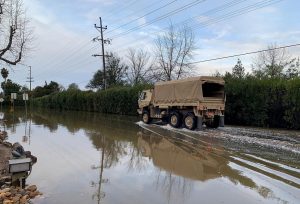After going through one of the worst storms damages in recent years, many of our neighbors on the coast of California are trying to recover some sense of normalcy. But the question is, what’s next? How do we become stronger and more resilient after this?
Ethnic Media Services and California Black Media hosted a statewide ethnic media briefing in partnership with Listos California, a program of the Governor’s Office of Emergency Services (Cal OES). In there, several agencies provided information about what can people do to recover from California’s devastating storm in January.
Diana Croft-Pelayo, Assistant Director, Crisis Communication & Public Affairs said that it is recommended people create an emergency plan with the family in case of a disaster.
“We are partnering with trusted messengers and community-based organizations through this recovery effort to maximize and help survivors get the resources that they need and also co-working with FEMA on a lot of this. Let this be a reminder for you to have those conversations with your family and make the difference for the next time an emergency strikes so that families are ready,” Pelayo-Croft said.
Governor Gavin Newsom signed an executive order on January 31st, 2023 to support the state’s ongoing storm response and recovery efforts, including provisions to ease access to unemployment benefits for impacted residents and help ensure adequate staffing by waiving work hour limitations for retired annuitants in local governments. The order also ended waivers enacted during the storms to facilitate fuel transportation and restoration of electrical power.
“Every time we go out and repair a damaged road or a damaged facility post-disaster, we’d highly encourage local communities to also invest in mitigation as well, to build back in a more resilient manner so that we can better withstand future disasters,” said Robert Troy, Assistant Director Emergency Recovery Coordination at Cal OES. “Storm events like this can take months and years to fully repair local infrastructure and local recovery capabilities,”
Among the designated counties for the declaration of emergency were Calaveras, Merced, Monterey, Sacramento, San Joaquin, San Luis Obispo, San Mateo, Santa Barbara, and Santa Cruz.
Business owners and taxpayers impacted by California’s winter storms were eligible for emergency tax relief from late payment interest and penalties.
“If you need extra funds because your business was impacted economically or your business has less cash available and you need Working Capital Loans, you may apply up to $2 Million in a combination. For example, if your business was impacted physically and you need funds to repair or replace the disaster property damage, including machinery, equipment, and inventory, among others, and at the same time you need a working capital loan in combination, the maximum about is up to $2 Million,” said Luis Santos-Serrano from Small Business Administration.
Impacts of the storms have been felt throughout the state, and small business owners who have been affected by flooding, power outages, and other storm-related hardships may request up to an additional three months to file their tax returns. Taxpayers who face return deadlines between January 4, 2023, and January 31, 2023, who are granted relief will not have to pay interest and penalties if they are unable to file their returns and pay taxes and fees by the original due date.
FEMA’s Individuals and Households Program (IHP) provides financial and direct services to eligible individuals and households affected by a disaster, who have uninsured or under-insured necessary expenses and serious needs. IHP assistance is not a substitute for insurance and cannot compensate for all losses caused by a disaster. The assistance is intended to meet your basic needs and supplement disaster recovery efforts.
IHP Assistance may include:
- Funds for temporary housing while you are unable to live in your home, such as rental assistance, or reimbursement for hotel costs
- A temporary housing unit, if approved for the disaster, when you are not able to use rental assistance due to a lack of available housing resources
- Funds to support the repair or replacement of owner-occupied homes that serve as the household’s primary residence, including privately-owned access routes, such as driveways, roads, or bridges
- Funds for other uninsured or under-insured disaster-caused expenses and serious needs, such as repair or replacement of personal property and vehicles, or funds for moving and storage, medical, dental, child care, funeral, and other miscellaneous items approved by your state, territory, or tribal government
- Funds for hazard mitigation assistance to help eligible homeowners repair or rebuild stronger, more durable homes.






